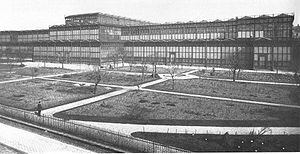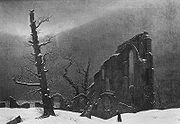.gif)
Glaspalast (Munich)
Encyclopedia

Glass
Glass is an amorphous solid material. Glasses are typically brittle and optically transparent.The most familiar type of glass, used for centuries in windows and drinking vessels, is soda-lime glass, composed of about 75% silica plus Na2O, CaO, and several minor additives...
and iron exhibition building in Munich
Munich
Munich The city's motto is "" . Before 2006, it was "Weltstadt mit Herz" . Its native name, , is derived from the Old High German Munichen, meaning "by the monks' place". The city's name derives from the monks of the Benedictine order who founded the city; hence the monk depicted on the city's coat...
modeled after The Crystal Palace
The Crystal Palace
The Crystal Palace was a cast-iron and glass building originally erected in Hyde Park, London, England, to house the Great Exhibition of 1851. More than 14,000 exhibitors from around the world gathered in the Palace's of exhibition space to display examples of the latest technology developed in...
in London. The Glaspalast opened for the Erste Allgemeine Deutsche Industrieausstellung (First General German Industrial Exhibition) on July 15, 1854.
Construction
The Glaspalast was ordered by Maximilian IIMaximilian II of Bavaria
Maximilian II of Bavaria was king of Bavaria from 1848 until 1864. He was son of Ludwig I of Bavaria and Therese of Saxe-Hildburghausen.-Crown Prince:...
, King of Bavaria
King of Bavaria
King of Bavaria was a title held by the hereditary Wittelsbach rulers of Bavaria in the state known as the Kingdom of Bavaria from 1805 until 1918, when the kingdom was abolished...
, built by MAN AG and designed by August von Voit
August von Voit
Richard Jakob August von Voit was a German architect.Voit designed the city hall of Annweiler am Trifels , the Fruchthalle in Kaiserslautern , the Neue Pinakothek and the Glaspalast for the Erste Allgemeine Deutsche...
, and hosted many large art exhibitions and international trade fairs.
The two-storied building was 234 meters (768 ft) long and 67 meters (220 ft) wide. The building's height measured 25 meters (82 ft). Construction was a mere six months, beginning December 31, 1853 and ending June 7, 1854, during which time 37,000 windows were installed. The total cost of construction was 800,000 gulden
South German gulden
The Gulden was the currency of the states of southern Germany between 1754 and 1873. These states included Bavaria, Baden, Württemberg, Frankfurt and Hohenzollern....
s.
The Erste Allgemeine Deutsche Industrieausstellung opened five weeks later, only three years after the completion of the Crystal Palace in London, which served as its model.
Electrification
In 1882 die erste elektrisch beleuchtete Internationale Elektrotechnische Ausstellung (the first electrically lit international electrotechnical exhibition) took place in the Glass Palace. The German engineer Oskar von MillerOskar von Miller
Oskar von Miller was a German engineer and founder of the Deutsches Museum, a large museum of technology and science....
had built a DC
Direct current
Direct current is the unidirectional flow of electric charge. Direct current is produced by such sources as batteries, thermocouples, solar cells, and commutator-type electric machines of the dynamo type. Direct current may flow in a conductor such as a wire, but can also flow through...
overhead power line from Miesbach
Miesbach
Miesbach is a town in Bavaria, Germany, and is the capital of the Miesbach district. The district is at an altitude of 697 metres above sea level. It covers an area of approximately 863.50 km² of alpine headlands and in 2004 had a population of 93,942. The town is located 48 km southeast...
, 50 km distant, to bring power to Munich. At the exhibition, an electrically powered pump for an artificial waterfall demonstrated the feasibility of bringing electrical power over long distances.
See also: Miesbach-Munich Power Transmission
Miesbach-Munich Power Transmission
Miesbach–Munich Power Transmission was the firsttransmission of electrical energy over a large distance.It took place in 1882 between a steam engine situated near Miesbach and the glass palace of Munich, where world's first international electricity exhibition took place. The voltage used was 2000...
Fire

Arson
Arson is the crime of intentionally or maliciously setting fire to structures or wildland areas. It may be distinguished from other causes such as spontaneous combustion and natural wildfires...
. The fire in the Glaspalast damaged more than 1,000 paintings and sculptures and destroyed more than 110 artworks from the early 19th century including many paintings by Caspar David Friedrich
Caspar David Friedrich
Caspar David Friedrich was a 19th-century German Romantic landscape painter, generally considered the most important German artist of his generation. He is best known for his mid-period allegorical landscapes which typically feature contemplative figures silhouetted against night skies, morning...
, Moritz von Schwind
Moritz von Schwind
thumb|Moritz von Schwind, c. 1860Moritz von Schwind was an Austrian painter, born in Vienna.Moritz von Schwind received rudimentary training and spent a happy and carefree youth in Vienna. Among his companions was the composer Schubert, some of whose songs he illustrated...
, Karl Blechen and Philipp Otto Runge
Philipp Otto Runge
Philipp Otto Runge was a Romantic German painter and draughtsman. He made a late start to his career and died young, nonetheless he is considered among the best German Romantic painters.- Life and work :...
. Only 80 artworks were salvaged after the fire.
After the fire, plans were made to rebuild the Glaspalast. However, the plans were abandoned in 1933 after seizure of power by the new Nazi government. Instead of rebuilding the palace, the government built the Haus der Kunst
Haus der Kunst
The Haus der Kunst is an art museum in Munich, Germany. It is located at Prinzregentenstrasse 1 at the southern edge of the Englischer Garten, Munich's largest park.-History:...
(House of Art) on the Prinzregentenstraße near the Englischer Garten
Englischer Garten (Munich)
The Englischer Garten, German for "English Garden", is a large public park in the centre of Munich, Germany, stretching from the city centre to the northeastern city limits...
(English Garden).
The fountain of the Glaspalast, which remained intact, today stands in the center of the Weißenburger Platz in the Haidhausen
Haidhausen (Munich)
Haidhausen is a suburb in Munich, Germany. It is now part of the borough —or stadtbezirk— number 5 Au-Haidhausen.-Location:Haidhausen is located above the suburb Au...
quarter of Munich.
External links
- Historisches Lexikon Bayerns: Glaspalast, München (German) Several photographs of the interior and exterior of the Glaspalast

